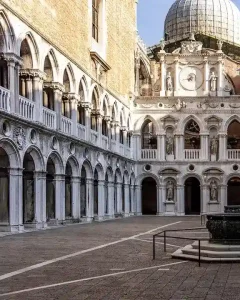Prosecco: From Ancient Vines to the UNESCO Hills of Veneto
Ever wondered where those fine bubbles in your glass come from? Welcome to the story of Prosecco — Italy’s most joyful wine, born among the Prosecco Hills north of Venice. This guide takes you from its Roman roots to the Charmat method, from hilltop vineyards to delicious pairings and cocktails — and shows how you can experience it all with Tour Leader Venice day tours.
📜 A Sparkling History — From “Puccino” to Prosecco
The story starts in Roman times, when a still wine called Puccino was prized near Trieste. Centuries later, winemakers in the Veneto refined the local Glera grape into the lively sparkling style we love today.
In the 19th century, Italian enologists perfected the Charmat Method — fermenting wine in sealed tanks instead of bottles. This made Prosecco quicker, fresher, and more affordable than Champagne. By the early 1900s, it was already the pride of the Veneto and Friuli regions.
- 1969: Creation of the official Prosecco DOC area.
- 2009: Upgrade to DOCG status for the best hillside zones — Conegliano Valdobbiadene Superiore and Asolo Superiore.
Today, Prosecco is a worldwide symbol of Italian style — light, floral, approachable, and the perfect start to any romantic experience in Venice.
🏭 How Prosecco Is Made — The Charmat Method Explained
The wine’s magic begins with the Glera grape. Here’s the journey from vineyard to glass:
- Harvest: September – October, mostly by hand on steep hills.
- Pressing & First Fermentation: Gentle pressing and cool stainless-steel fermentation preserve aroma.
- Blending: Different parcels combined for balance and freshness.
- Second Fermentation: Sugar + yeast added in sealed tanks — this is when the bubbles are born.
- Aging & Filtration: Short aging (to keep it crisp) before bottling under pressure.
Unlike Champagne, Prosecco is designed to be enjoyed young — ideally within a year of bottling — capturing its signature vitality.
🏞️ The UNESCO Prosecco Hills
In 2019 the Prosecco Hills of Conegliano and Valdobbiadene became a UNESCO World Heritage Site, honoring their centuries-old viticulture and dramatic landscape. Terraced vineyards, stone walls, and narrow ridges known as “hogbacks” create both beauty and biodiversity.
You can explore them on our Unforgettable Prosecco Hills Drive & Cooking Experience — a perfect day trip from Venice that includes tastings, scenic stops, and a farm-to-table lunch.
📍 DOCG Regions & Signature Styles
🍏 Conegliano Valdobbiadene Superiore DOCG
The historic heartland of Prosecco. Hillside vineyards yield elegant, floral wines with crisp acidity and fine bubbles.
🍐 Valdobbiadene Prosecco Superiore DOCG
Produces some of the most delicate and refined bottles — perfect as an aperitif or paired with light Venetian seafood.
🍑 Asolo Prosecco Superiore DOCG
From the romantic hill town of Asolo. Slightly riper and rounder in style, it’s a favorite among wine lovers seeking authenticity.
🥇 Cartizze Cru
The “Grand Cru” of Prosecco: only 107 hectares of south-facing vineyards near Valdobbiadene. Expect creamy texture, aromas of peach, pear, and almond, and exceptional finesse.
🌬️ Frizzante, Spumante & Col Fondo
- Frizzante: lightly sparkling, easy-going, and food-friendly.
- Spumante: fully sparkling with persistent, fine mousse — the classic Prosecco style.
- Col Fondo: traditional bottle-fermented Prosecco, unfiltered and slightly cloudy — try it on our Flavors of Veneto Tour for an authentic taste of the old ways.
🍬 Sweetness Levels (Residual Sugar)
- Brut: 0–12 g/L — crisp and dry; great with Venetian cicchetti and seafood.
- Extra Dry: 12–17 g/L — slightly softer; the classic balance for aperitifs.
- Dry: 17–32 g/L — fruity and rounded; pairs beautifully with salty cheese or desserts.
🍽️ What to Eat with Prosecco
- Antipasti platters and Venetian seafood bites.
- Light pasta and risotto dishes — try risotto al Prosecco in the hills.
- Grilled fish or shrimp by the lagoon.
- Soft cheeses like brie or fresh goat cheese.
- Fruit desserts or Venetian bussolà cookies with Dry Prosecco.
🍹 Easy Prosecco Cocktails
Venetian Spritz
3 parts Prosecco + 2 parts Aperol + 1 part soda. Add ice and an orange slice — best enjoyed after our Cicchetti & Wine Tour.
Bellini
2 parts Prosecco + 1 part fresh white peach purée — born right here in Venice at Harry’s Bar!
🍇 Where to Taste Prosecco
- Conegliano: visit the historic wine school and museum.
- Valdobbiadene: rolling vineyards and family-run wineries.
- Asolo: elegant hilltop town with panoramic views and boutique cellars.
- Venice: sip a glass on our Venice Sunset Tour on a Traditional Bragozzo Boat — sparkling wine in hand as the sky glows gold.
- Prosecco Road (Strada del Prosecco): 50 km of vineyards between Conegliano and Valdobbiadene — included in our Explore the Prosecco Hills Tour.
🏅 How to Choose the Best Bottle
- Look for the DOCG seal (guaranteed origin and quality).
- Prefer recent vintages — Prosecco is meant to be fresh.
- Try a single-vineyard or cru for special occasions.
- Support small sustainable producers along the UNESCO hills.
Prosecco is more than a wine — it’s the sparkle of the Veneto spirit. Want to taste it where it was born? Join our Unforgettable Prosecco Hills Tour or Explore the Prosecco Hills Experience — private transfers, boutique wineries, and a glass raised to la dolce vita. 🍾
FAQs About Prosecco and the UNESCO Hills
Where are the Prosecco Hills located?
The Prosecco Hills stretch between Conegliano, Valdobbiadene, and Asolo, about an hour north of Venice. This UNESCO World Heritage landscape is dotted with terraced vineyards, stone farmhouses, and panoramic tasting terraces. You can experience it on our Unforgettable Prosecco Hills Drive & Cooking Experience — the perfect day trip from Venice.
What’s the difference between DOC and DOCG Prosecco?
DOC Prosecco comes from the wider Veneto and Friuli area, while DOCG wines — such as Conegliano Valdobbiadene Superiore and Asolo Prosecco Superiore — are produced in the most prestigious hillside vineyards. These DOCG bottles offer finer bubbles, greater complexity, and the true flavor of the region. Taste both styles during our Explore the Prosecco Hills Tour.
Can I visit the Prosecco Hills from Venice in one day?
Yes — it’s one of the most rewarding day trips from Venice. Our Discover the Flavors of Veneto Tour and Adopt a Vineyard of Asolo Prosecco Superiore DOCG experiences include private transfers, tastings, and visits to family-run wineries surrounded by breathtaking landscapes.







